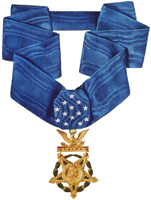 The first act of Congress authorizing “medals of honor” for Army personnel was approved by President Abraham Lincoln on July 12, 1862. The Medal of Honor is presented to its recipients “in the name of Congress of the United States.” For this reason, it is often referred to as the Congressional Medal of Honor. However, the proper name is Medal of Honor. The Army, Navy and Air Force each have their own Medal of Honor design.
The first act of Congress authorizing “medals of honor” for Army personnel was approved by President Abraham Lincoln on July 12, 1862. The Medal of Honor is presented to its recipients “in the name of Congress of the United States.” For this reason, it is often referred to as the Congressional Medal of Honor. However, the proper name is Medal of Honor. The Army, Navy and Air Force each have their own Medal of Honor design.
Gen. George Washington created the Badge of Military Merit at Newburgh, New York, on Aug. 7, 1782, but it fell into disuse after the Revolutionary War. Decorations, as such, still were too closely related to European royalty to be of concern to the American people.
However, when the American people witnessed the fierce fighting and deeds of valor performed so close to home during the Civil War, they realized such valor must be recognized. Legislation was introduced in the Senate on Feb. 17, 1862, which followed the pattern of a similar award approved for Naval personnel I December 1861.
The Resolution provided:
“The President of the United States be, and he is ready authorized to cause two thousand ‘medals of honor’ to be prepared with suitable emblematic devices, and to direct that the same be presented, in the name of Congress, to such noncommissioned officers and privates as shall most distinguish themselves by their gallantry in action, and other soldier-like qualities during the present insurrection, and that the sum of ten thousand dollars be, and the same is hereby appropriated out of any money in the Treasury not otherwise appropriated for the purpose of carrying this resolution into effect.”
This law was amended on March 3, 1863, to extend its provision to include officers.
Misuse of the medal led to a change in design and more specific regulations governing its award. The first change was recommended by The Adjutant General of the Army in 1896 because the original ribbon design had been imitated by non-military organizations.
In 1904, the many ambiguities of law regarding the award of the medal resulted in a second change. This time the change included a completely new design of the medal itself. The medal was worn either suspended from the neck or pinned over the left breast in precedence to other military decorations. Stronger laws to protect the medal were enacted also.
The present neck ribbon was adopted in 1944. It is worn outside the shirt collar and inside the coat, hanging above all other decorations. Except for the Legion of Merit, Degree of Commander, awarded only to foreigners, the Medal of Honor is the only United States neck decoration.
Many awards for service during the Civil War were made based only upon application of the recipient. On June 3, 1916, Congress directed the Secretary of War to appoint a board of five retired general officers to “investigate and report upon past awards of issue of the so-called Congressional Medal of Honor…and in any case in which said board shall find and report that said medal was issued for any cause other than distinguished conduct involving actual conflict with any enemy, the name of the recipient of the medal so issued shall be stricken permanently from the official Medal of Honor list…”
The Board concluded its review on Feb. 15, 1917, and had stricken 911 names. Of the 911 cases, 864 involved awards to members of the 27th Maine Infantry. Volunteers from that regiment had been requested to remain in service beyond the expiration of their reenlistment for “mopping up” operations. It was intended to awards Medals of Honor to those who responded but by some misadventure, medals were awarded to the entire regiment. Other canceled awards included those to the honor guard which accompanied the body of President Lincoln from Washington, D.C., to Springfield, Ill.; to “Buffalo Bill” Cody; and to Dr. Mary Walker, the only woman awarded the Medal of Honor. Dr. Walker’s medal was reinstated by the Army in 1977.
World War I highlighted the need to clarify the criteria for the Medal of Honor. The act on July 9, 1918, established the criteria which are in effect today. That act provided, “The president may award, and present in the name of Congress, a Medal of Honor to a person who, while a member of the Army and in action involving actual conflict with an enemy, distinguishes himself conspicuously by gallantry and intrepidity at the risk of his life above and beyond the call of duty.”
The Medal of Honor Roll, established by Congress on April 27, 1916, provided that upon reaching age 65, each Medal of Honor recipient who was honorably discharged from the service by muster-out, resignation, or otherwise, would have his name entered on the Roll and be eligible for a special pension of $10 per month for life. The act was amended on Aug. 14, 1961, to increase the amount of the pension to $100 per month, decrease the age to 50 and remove the requirement of separation from the service. It was further amended on Oct. 13, 1964, to decrease the age to 40. On Oct. 31, 1965, the act once again was amended by deleting the age of the awardee as a requirement for the special pension of $100 per month.

